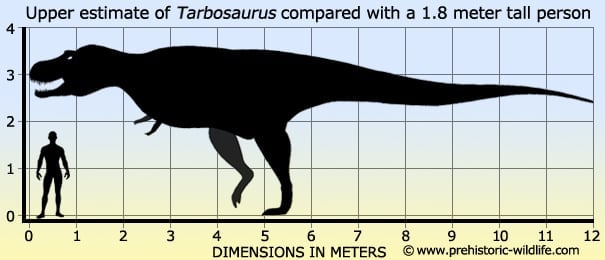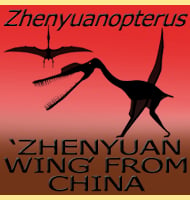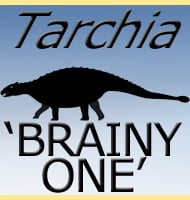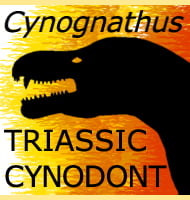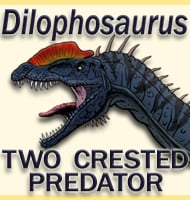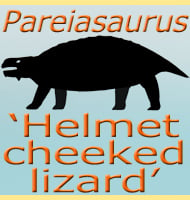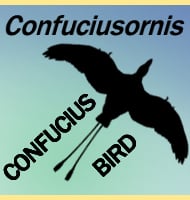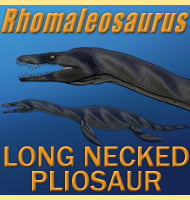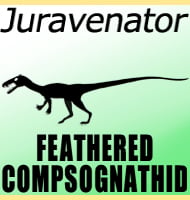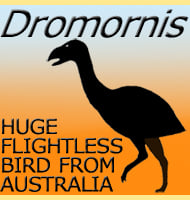Classification history and complications
When Tarbosaurus fossils were first discovered many of them were actually assigned as new species to the existing tyrannosauroid genera Tyrannosaurus (T. bataar) and Gorgosaurus (G. lancinator & G. novojilovi), as well as the new genus and species, Tarbosaurus efremovi.
This classification continued until 1965 when Anatoly Konstantinovich Rozhdestvensky realised that that all of these specimens represented the same genus, merely at different growth stages.
All of the other specimens were subsequently included into the genus as Tarbosaurus with the new type species being called T. bataar, but while most palaeontologists agreed with this some still referred to the type species as T. efremovi.
This classification continued without much issue until 1992 when Kenneth Carpenter examined the fossils and came to the conclusion that most of the fossils actually belonged within the Tyrannosaurus genus.
The exception to this was the material that had originally been classed as Gorgosaurus novojilovi which was placed in its own genus Maleevosaurus. However this actually ended up being synonymised back into Tarbosaurus in 1999. In 1995 George Olshevsky created another name for the Tyrannosaurus bataar material calling it Jenghizkhan, as well as recognising previous genera and species.
After the end of the twentieth century the vast majority of palaeontologists only recognised either Tarbosaurus bataar or Tyrannosaurus bataar as being legitimate.
As time goes on and further study is undertaken, more and more people are recognising Tarbosaurus as its own legitimate genus with key differences being its even smaller arms than those found in Tyrannosaurus, a different orientation of the eyes, skull structure and a lower jaw structure that is different from any currently known North American tyrannosaur.
Another Asian tyrannosaur named Alioramus was also for a long time considered to be a synonym to Tarbosaurus. This continued until the discovery of a second set of remains which was attributed to a new species of Alioramus that confirmed Alioramus as a unique genus totally separate from Tarbosaurus.
Tarbosaurus as a living animal
Of all the currently known tyrannosauroids, Tarbosaurus was one of the larger members of the group. Tarbosaurus is also one of the best known members with a relatively large amount of fossils attributed to the genus.
It is partly because of this large size that Tarbosaurus has for a long time been assumed to be synonymous with Tyrannosaurus, the only other tyrannosaurid currently known to have been larger.
Despite this size similarity there are a few key differences between these two tyrannosaur genera that are convincing an increasing number of people into classifying them as separate.
Two key areas of difference are the tiny arms of Tarbosaurus. While all of the later tyrannosauroids are famous for having disproportionately small arms, Tarbosaurus has arms that are even smaller than the rest.
The two clawed digits that were Tarbosaurus’s ‘hands’ were also different to other tyrannosaurs. The second metacarpal is under half the length of the first metacarpal, something that is the other way around in other known tyrannosaurid genera.
The large number of skulls for Tarbosaurus has allowed for detailed study into how they worked and different from other tyrannosaurids. Often in tyrannsoaurids stresses on the bones from the jaws biting down are transmitted through the maxilla to the nasal bones which have a reinforced connection to the lacrimal bones via bony struts, presumably to transmit excess stress to the lacrimal so that the stress was distributed across a larger area. In Tarbosaurus these struts are absent resulting in a weaker connection between the lacrimal and nasal bones.
Tarbosaurus however does have an enlarged bony extension from the maxilla that drives into the lacrimal bone indicating that the stresses from biting forces were passed directly to the lacrimal bone. The lacrimal also had a more secure fixing to the prefrontal and frontal skull bones that together made the skull much more rigid than other tyrannosaurids.
The rigid construction of Tarbosaurus’s head also continued to the lower jaw where a bony ridge that ran down to the dentary which formed what has been termed a ‘locking mechanism’. This made the lower jaws very rigid and better able to hold onto powerful struggling prey.
North American contempories at this time lacked the reinforcement and instead had more flexible lower jaws. This reinforced jaw is however also seen in Alioramus, and is thought to have been formed as a result of a different evolutionary line of tyrannosaurids, or quite possibly to deal with different types of prey.
Skull study has also allowed for reconstructions of Tarbosaurus’s brain to made, something that led to the discovery that it was very similar to other tyrannosaurids. As such Tarbosaurus had a brain that was more like that of a crocodile than that of a bird.
The most developed areas of the brain were the areas associated with smell. These were extremely well developed and there was also the presence of a vomeronasal organ, something that would have helped it to detect pheromones.
This means that the sense of smell was very important to Tarbosaurus, and it may have needed to use smell to track others of its kind when looking for a mate.
Tarbosaurus also had well developed hearing that suggests members of its species may have called out to one another, either to establish territorial boundaries or to attract potential mates into their areas.
Tarbosaurus also seems to have had a well-developed sense of balance, something that may have helped it greatly as the sideward position of the eyes suggest that it may have had to turn its head to one side so that it could look forward to clearly see where it was walking.
The visual centres of the brain however are actually quite underdeveloped, and one key reason for this could be the shape of the skull. Because the back of Tarbosaurus’s skull is quite narrow, the eyes looked out more to the sides rather than directly ahead.
This means that Tarbosaurus did not have the sharp stereoscopic vision that other tyrannosaurids had, and aside from potentially having a blind spot in front of its snout, it would not have been able to gauge distances as effectively as other tyrannosaurids. This may not have been a critical flaw however as if Tarbosaurus had a preference for hunting larger and slower prey animals, it would not have had such a great reliance upon vision.
Tarbosaurus hunting and possible prey specialisation
The highly developed sense of smell combined with the underdeveloped sight can be used to draw the easy conclusion that Tarbosaurus was adapted more for scavenging than active hunting.
However such a quick conclusion may not be the correct one when you look at the fossils of the rest of the animal as well as potential prey items. Dinosaurs, particularly predatory ones, are always studied for signs of stress fractures, injuries and damage caused by repeated actions throughout the animal’s life.
The key area for stress fractures in Tarbosaurus was surprisingly found in the hands, an area that could not be in contact with the ground.
The most plausible explanation for the presence of an injury caused by repeated behaviour would be contact with another large dinosaur, another of its own kind or perhaps a large prey item.
Tarbosaurus also did not have the acute stereoscopic (binocular) vision associated with its North American cousins. Some possible prey items were large hadrosaurs like Saurolophus, but there were also titanosaurid sauropods such as Nemegtosaurus.
These large dinosaurs would not require exceptional vision to find and hunt and would have quite possibly been slow on their feet making them viable prey for capture. Their size however would require Tarbosaurus to get close and physical to make a kill, a possible explanation for the stress fracture to the hand.
Many of the other dinosaurs in the region would have been smaller and often swifter than Tarbosaurus, meaning that it would have been restricted to the larger dinosaurs that other smaller tyrannosauroids like Alioramus were better adapted to catch.
Whereas the potential is there for Tarbosaurus to have been an active hunter, it may still have had a greater tendency to turn to scavenging to augment its diet than others of its group.
It may have even used its sheer size and bulk to intimidate other smaller predators into giving up their kills, behaviour that can be observed in carnivores that are still active predators today.
Further Reading
- – New carnivorous dinosaurs from the Upper Cretaceous of Mongolia. – Doklady Akademii Nauk SSSR 104 (5): 779–783. – Evgeny A. Maleev – 1955. – Giant carnivorous dinosaurs of Mongolia – Doklady Akademii Nauk SSSR 104 (4): 634–637. – Evgeny A. Maleev – 1955. – Growth changes in Asian dinosaurs and some problems of their taxonomy – Paleontological Journal 3: 95–109. – Anatoly K. Rozhdestvensky – 1965. – Gigantic carnosaurs of the family Tyrannosauridae – The Joint Soviet-Mongolian Paleontological Expedition Transactions 1: 132–191. – Evgeny A. Maleev – 1974. – A new Late Cretaceous carnosaur from Nogon−Tsav, Mongolia – The Joint Soviet-Mongolian Paleontological Expedition Transactions (in Russian) 3: 93–104 – Sergei M. Kurzanov – 1976. – Carnivorous dinosaurs from the Cretaceous of Mongolia – The Joint Soviet-Mongolian Paleontological Expedition Transactions 19: 5–119. – Rinchen Barsbold – 1983. – Late Mesozoic stratigraphy and vertebrates of the Gobi Basin – Cretaceous Research 12 (4): 345–377 – Tomasz Jerzykiewicz & Dale A. Russell – 1991. – New information on Shanshanosaurus huoyanshanensis, a juvenile tyrannosaurid (Theropoda, Dinosauria) from the Late Cretaceous of China – Canadian Journal of Earth Sciences 38 (12): 1729–1737. – Philip J Currie, & Dong Zhiming – 2001. – Skull structure and evolution in tyrannosaurid phylogeny, Acta Palaeontologica Polonica 48 (2): 227–234. – Philip J. Currie, J�rn H Hurum & Karol Sabath – 2003. – Giant theropod dinosaurs from Asia and North America: Skulls of Tarbosaurus bataar and Tyrannosaurus rex compared – Acta Palaeontologica Polonica 48 (2): 161–190. – J�rn H. Hurum & Karol Sabath – 2003. – A new study of the brain of the predatory dinosaur Tarbosaurus bataar (Theropoda, Tyrannosauridae) – Paleontological Journal 41 (3): 281–289 – Sergei V. Saveliev & Vladimir R. Alifanov – 2005. – Cranial Osteology of a Juvenile Specimen of Tarbosaurus bataar (Theropoda, Tyrannosauridae) from the Nemegt Formation (Upper Cretaceous) of Bugin Tsav, Mongolia – Journal of Vertebrate Paleontology 31 (3): 497–517. – Takanobu Tsuihiji, Mahito Watabe, Khishigjav Tsogtbaatar, Takehisa Tsubamoto, Rinchen Barsbold, Shigeru Suzuki, Andrew H. Lee, Ryan C. Ridgely, Yasuhiro Kawahara & Lawrence M. Witmer – 2011. – Tyrannosaur feeding traces on Deinocheirus (Theropoda:?Ornithomimosauria) remains from the Nemegt Formation (Late Cretaceous), Mongolia. – Cretaceous Research. 37: 186–190. – P. R. Bell, P. J. Currie & Y. N. Lee – 2012. – Diet preferences and climate inferred from oxygen and carbon isotopes of tooth enamel of Tarbosaurus bataar (Nemegt Formation, Upper Cretaceous, Mongolia). – Palaeogeography, Palaeoclimatology, Palaeoecology. 537: 109190. – Krzysztof Owocki, Barbara Kremer, Martin Cotte & Herv� Bocherens – 2020.
